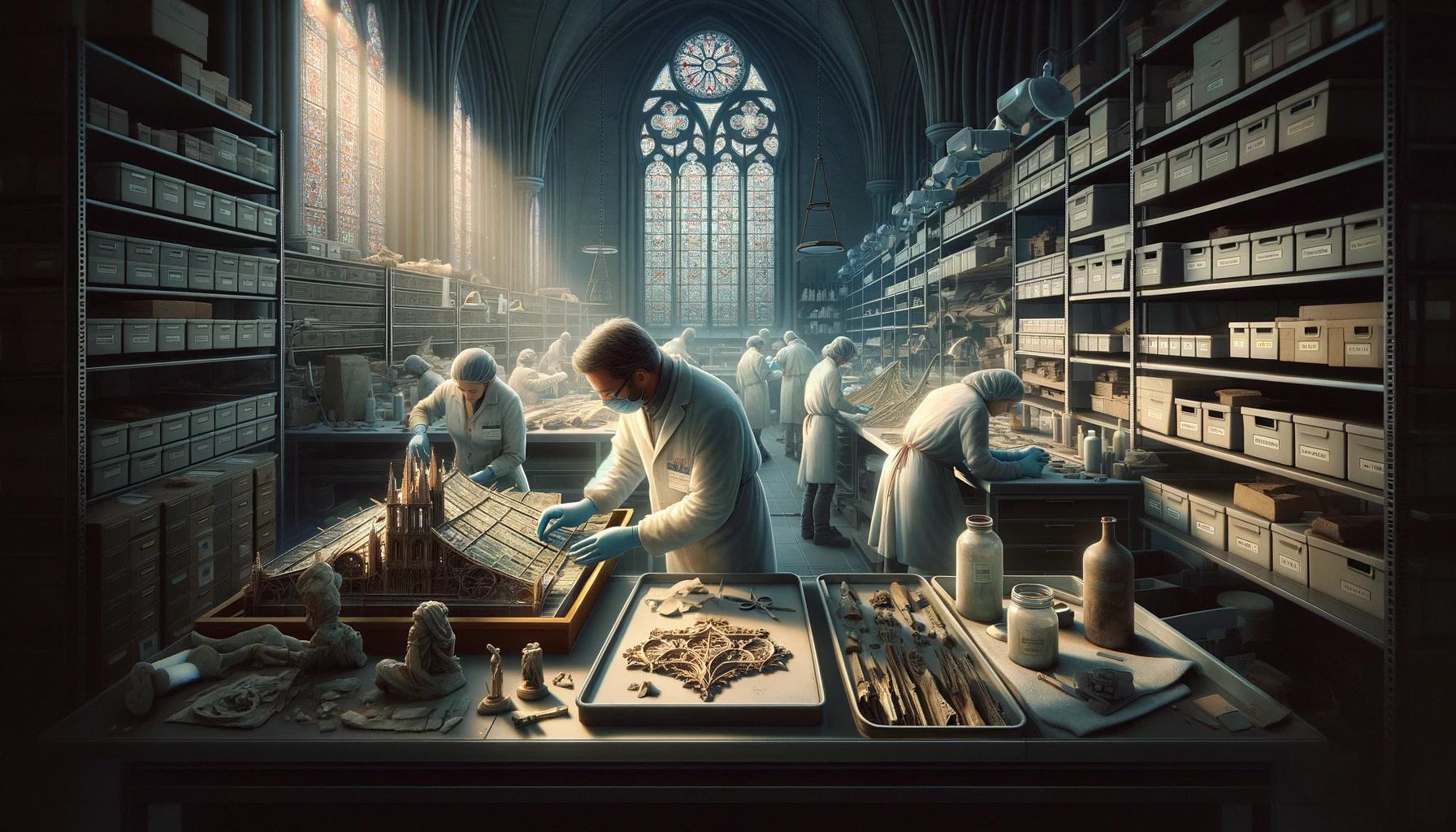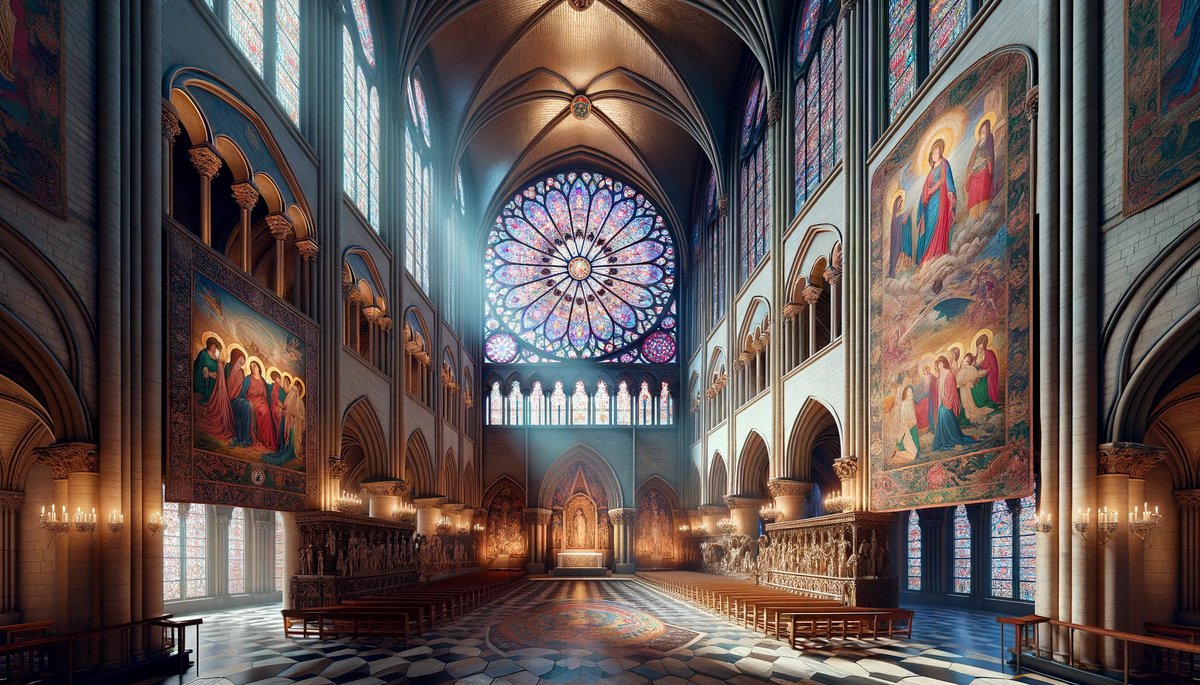Home>Arts and Culture>What Relics Were In Notre Dame Cathedral


Arts and Culture
What Relics Were In Notre Dame Cathedral
Published: February 17, 2024
Ericka Andersen, an editor at Christian.net, expertly merges digital strategy with content creation, focusing on faith and societal issues. Her communication skills enhance the platform's engaging narratives, fostering meaningful dialogue on belief's impact on society.
Discover the historic relics housed in Notre Dame Cathedral, including priceless artifacts and cultural treasures. Explore the arts and culture of this iconic landmark.
(Many of the links in this article redirect to a specific reviewed product. Your purchase of these products through affiliate links helps to generate commission for Christian.net, at no extra cost. Learn more)
Table of Contents
Introduction
The Notre Dame Cathedral, a timeless symbol of Paris and a masterpiece of French Gothic architecture, has long stood as a testament to human ingenuity and spiritual devotion. This iconic structure, with its soaring spires and intricate rose windows, has been a beacon of faith and a repository of history for over 850 years. However, the world was stunned when news of the devastating fire that engulfed the cathedral on April 15, 2019, spread across the globe.
The fire, which raged for hours, caused significant damage to the cathedral, including the collapse of the spire and the destruction of the roof. As the world watched in disbelief, the fate of the priceless relics housed within the cathedral became a matter of grave concern. These relics, revered artifacts with profound religious and historical significance, have been an integral part of the cathedral's identity and have drawn countless pilgrims and visitors over the centuries.
The Notre Dame Cathedral, often referred to as "Our Lady of Paris," has been a place of pilgrimage and worship, a cultural touchstone, and a living testament to the enduring power of faith and artistry. The relics housed within its hallowed walls have been cherished as tangible connections to the divine and as links to the rich tapestry of Christian history. The cathedral's significance extends far beyond its architectural grandeur; it embodies the collective spirit of humanity and the enduring legacy of religious devotion.
As we delve into the history of the Notre Dame Cathedral and explore the profound importance of relics in Catholicism, we will gain a deeper understanding of the cultural and spiritual significance of these artifacts. Furthermore, we will examine the relics that were housed within the cathedral before the tragic fire, the miraculous preservation of certain relics, and the current status of these precious artifacts. Through this exploration, we will come to appreciate the enduring resilience of faith and the timeless allure of relics that have transcended centuries of human history.
Read more: What Is Notre Dame Cathedral Made Of
History of Notre Dame Cathedral
The history of the Notre Dame Cathedral is a captivating saga that intertwines the realms of religion, architecture, and cultural heritage. Construction of this magnificent edifice began in 1163, during the reign of King Louis VII, and it took nearly 200 years to complete. The cathedral, dedicated to the Virgin Mary, stands on the Île de la Cité, a natural island in the Seine River that has been a focal point of Parisian life for centuries.
The visionary design of Notre Dame, characterized by its towering spires, flying buttresses, and awe-inspiring rose windows, exemplifies the pinnacle of Gothic architecture. The cathedral's construction marked a pivotal moment in the evolution of architectural techniques, as it showcased the innovative use of rib vaults and pointed arches, allowing for soaring interior spaces and intricate ornamentation.
Notre Dame Cathedral has borne witness to a multitude of historical events, serving as the backdrop for royal coronations, religious ceremonies, and significant cultural milestones. Its enduring presence has weathered the ravages of time, including the French Revolution and World War II, emerging as a resilient symbol of Parisian identity and spiritual continuity.
The cathedral's significance extends beyond its architectural splendor, as it has been a repository of sacred relics, including the Crown of Thorns and a fragment of the True Cross, which have drawn pilgrims and the faithful from around the world. These relics, imbued with profound religious significance, have been venerated within the cathedral's sacred precincts, adding to its aura of sanctity and historical resonance.
Notre Dame Cathedral has also inspired countless works of art, literature, and music, capturing the imaginations of artists and writers across the centuries. Victor Hugo's novel "The Hunchback of Notre-Dame" brought the cathedral to international prominence, further cementing its status as a cultural icon and a testament to human creativity and spiritual aspiration.
The cathedral's enduring legacy was tragically tested by the devastating fire of 2019, which caused significant damage to its structure and interior. However, the outpouring of global support and the commitment to its restoration underscore the profound significance of Notre Dame Cathedral as a living testament to the enduring spirit of faith, artistry, and human resilience.
As we reflect on the rich tapestry of Notre Dame's history, we are reminded of its timeless allure and its role as a custodian of collective memory and spiritual devotion. The cathedral stands as a testament to the enduring power of human creativity and the transcendent beauty of religious expression, inviting visitors to contemplate the interwoven threads of history, faith, and cultural heritage that converge within its sacred walls.
Importance of Relics in Catholicism
Relics hold a profound significance in Catholicism, serving as tangible connections to the divine and as conduits of spiritual grace. These sacred artifacts, which encompass a wide array of objects associated with saints, martyrs, and biblical figures, are revered for their ability to inspire devotion, foster spiritual contemplation, and facilitate miraculous intercession. Within the framework of Catholic theology, relics are categorized into three classes: first-class relics, which are physical remains of a saint or a fragment of an object directly associated with Christ; second-class relics, which are items that the saint used or touched; and third-class relics, which are objects that have been in contact with a first-class relic.
The veneration of relics is deeply rooted in the belief in the communion of saints, which asserts the spiritual solidarity and intercessory power of the saints in heaven. Catholics view relics as tangible manifestations of this spiritual communion, and they hold them in high esteem as conduits of divine grace and as symbols of the triumph of faith over earthly limitations. The presence of relics within sacred spaces, such as cathedrals and shrines, serves to deepen the spiritual resonance of these sites and to foster a sense of continuity with the martyrs and saints who have borne witness to the faith.
Furthermore, relics play a central role in the devotional life of Catholics, as they are believed to possess the power to heal the sick, protect against spiritual harm, and serve as focal points for prayer and contemplation. Pilgrimages to sites housing revered relics have been a longstanding tradition in Catholicism, allowing the faithful to seek solace, guidance, and spiritual renewal through their encounters with these sacred objects. The act of venerating relics is seen as an expression of faith and a tangible affirmation of the enduring presence of the divine within the material world.
In the broader context of Catholic spirituality, relics serve as tangible links to the historical and theological foundations of the faith, embodying the enduring legacy of the early Christian martyrs and the apostolic tradition. They evoke a sense of continuity with the ancient roots of Christianity and provide a tangible connection to the lives of the saints, whose exemplary virtues and steadfast faith continue to inspire and guide believers.
The Notre Dame Cathedral, as a revered pilgrimage site and a repository of sacred relics, has embodied the enduring significance of these artifacts within the Catholic tradition. The relics housed within its sacred precincts have drawn countless pilgrims and visitors, fostering a deep sense of spiritual connection and historical continuity. The cathedral's role as a custodian of relics underscores the enduring power of these sacred artifacts to inspire faith, foster contemplation, and evoke the timeless legacy of Christian devotion.
Relics in Notre Dame Cathedral Before the Fire
The Notre Dame Cathedral, a revered sanctuary of faith and a testament to human creativity, housed a collection of priceless relics that bore profound religious and historical significance. Among the most revered relics enshrined within its sacred walls were the Crown of Thorns, a fragment of the True Cross, and the tunic of Saint Louis. These relics, cherished as tangible links to the life of Christ and the martyrs of the early Christian tradition, had drawn pilgrims and the faithful from around the world, evoking a sense of awe and spiritual contemplation.
The Crown of Thorns, believed to be the very crown placed on Jesus' head during the crucifixion, held a central place in the cathedral's treasury of relics. Housed within an ornate reliquary, the Crown of Thorns symbolized the redemptive sacrifice of Christ and served as a focal point for veneration and prayer. Its presence within the cathedral had been a source of profound spiritual inspiration, drawing countless pilgrims and visitors who sought to contemplate the significance of this sacred artifact.
In addition to the Crown of Thorns, the cathedral safeguarded a fragment of the True Cross, a relic that held deep significance within the Christian tradition. This fragment, believed to be a portion of the cross on which Christ was crucified, served as a potent symbol of redemption and divine mercy. Pilgrims and the faithful were drawn to the cathedral to behold this relic, seeking solace and spiritual renewal through their encounters with this tangible link to the central event of Christian salvation.
Furthermore, the tunic of Saint Louis, a revered relic associated with the pious King Louis IX of France, added to the cathedral's treasury of sacred artifacts. This relic, believed to have been worn by Saint Louis himself, embodied the spirit of Christian kingship and devotion, serving as a testament to the intertwining of faith and temporal authority. Its presence within the cathedral spoke to the enduring legacy of Saint Louis and his unwavering commitment to the Christian virtues of compassion and justice.
These relics, along with numerous others housed within the Notre Dame Cathedral, formed a rich tapestry of spiritual and historical significance. Their presence within the sacred precincts of the cathedral had imbued the space with a profound sense of sanctity and historical resonance, inviting visitors to contemplate the enduring legacy of Christian faith and the enduring power of relics to inspire devotion and contemplation.
The relics in Notre Dame Cathedral before the fire stood as tangible testaments to the enduring power of faith and the timeless allure of sacred artifacts that have transcended centuries of human history. Their presence within the cathedral's hallowed walls had fostered a deep sense of spiritual connection and historical continuity, inviting pilgrims and visitors to partake in the living legacy of Christian devotion and the enduring resonance of sacred relics.
Relics Saved from the Fire
As the devastating inferno engulfed the Notre Dame Cathedral on April 15, 2019, the fate of the priceless relics housed within its sacred confines became a matter of grave concern. Amidst the chaos and anguish that gripped the world, a glimmer of hope emerged as reports surfaced of the miraculous rescue of several revered relics from the ravages of the fire.
One of the most remarkable feats of preservation was the rescue of the Crown of Thorns, a relic believed to be the very crown placed on Jesus' head during the crucifixion. Despite the intense heat and perilous conditions, a human chain of brave individuals, including firefighters and clergy, formed to rescue this sacred artifact from the blazing inferno. Their courageous efforts, undertaken amidst the looming threat of collapse and destruction, ensured the safe passage of the Crown of Thorns to a secure location, averting its potential loss to the flames.
In addition to the miraculous rescue of the Crown of Thorns, other precious relics, including a fragment of the True Cross and the tunic of Saint Louis, were also safeguarded from the fire's destructive reach. The swift and coordinated response of emergency personnel and dedicated individuals, driven by a shared commitment to preserving these irreplaceable artifacts, exemplified the triumph of human resolve in the face of adversity.
The preservation of these relics from the engulfing flames symbolized a testament to the enduring resilience of faith and the unwavering dedication to safeguarding the cultural and spiritual heritage embodied within the Notre Dame Cathedral. The collective efforts to ensure the safety of these relics underscored the profound significance of these artifacts as living links to the historical and spiritual legacy of Christianity.
The miraculous preservation of these relics from the devastating fire served as a poignant reminder of the enduring power of human determination and solidarity in the face of crisis. Their rescue from the brink of destruction symbolized a triumph of hope and resilience, reaffirming the timeless significance of these sacred artifacts as beacons of faith and historical continuity.
The relics saved from the fire bore witness to the indomitable spirit of human endeavor and the enduring legacy of faith that transcends the passage of time. Their preservation stood as a testament to the collective commitment to safeguarding the cultural and spiritual treasures embodied within the Notre Dame Cathedral, inspiring a renewed sense of reverence and appreciation for these irreplaceable relics.
Read more: What Happened To The Cathedral Of Notre Dame
Current Status of Relics from Notre Dame Cathedral
In the aftermath of the devastating fire that engulfed the Notre Dame Cathedral, the world awaited news regarding the fate of the priceless relics housed within its sacred walls. The preservation of these revered artifacts, including the Crown of Thorns, a fragment of the True Cross, and the tunic of Saint Louis, became a matter of global concern and fervent hope.
Following the heroic efforts to rescue the relics from the ravages of the fire, a collective sigh of relief echoed across the globe as reports confirmed the safe preservation of these irreplaceable artifacts. The Crown of Thorns, a symbol of Christ's redemptive sacrifice, was secured and transferred to the Louvre Museum for safekeeping, where it underwent meticulous examination and restoration. The fragment of the True Cross and the tunic of Saint Louis were also safeguarded and entrusted to the care of experts, ensuring their protection and eventual return to the restored cathedral.
The meticulous restoration and preservation efforts undertaken by dedicated experts and conservators have been instrumental in ensuring the long-term safeguarding of these relics. Their commitment to preserving the integrity and historical significance of these artifacts reflects a profound reverence for the enduring legacy of faith and cultural heritage embodied within the Notre Dame Cathedral.
As the restoration of the cathedral progresses, plans for the eventual return of the rescued relics to their rightful place within the sacred precincts of Notre Dame have been met with anticipation and solemn reverence. The symbolic significance of these relics, as tangible links to the historical and spiritual legacy of Christianity, underscores their enduring resonance and the profound impact they hold for pilgrims and visitors alike.
The current status of the relics from Notre Dame Cathedral stands as a testament to the unwavering commitment to preserving the cultural and spiritual heritage embodied within this iconic edifice. The meticulous restoration and safeguarding of these relics symbolize a triumph of human determination and solidarity, reaffirming their timeless significance as beacons of faith and historical continuity.
As the world eagerly awaits the eventual return of these revered relics to the restored Notre Dame Cathedral, their preservation serves as a poignant reminder of the enduring power of human endeavor and the timeless allure of sacred artifacts that have transcended centuries of human history.














